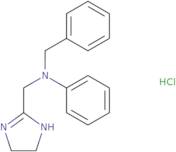Informations sur le produit
- 1H-Imidazole-2-methanamine, 4,5-dihydro-N-phenyl-N-(phenylmethyl)-, hydrochloride (1:1)
- 1H-Imidazole-2-methanamine, 4,5-dihydro-N-phenyl-N-(phenylmethyl)-, monohydrochloride
- 2-(N-Benzylanilinomethyl)-2-imidazoline hydrochloride
- 2-Imidazoline, 2-[(N-benzylanilino)methyl]-, monohydrochloride
- 2-{[benzyl(phenyl)amino]methyl}-4,5-dihydro-1H-imidazol-3-ium
- 5512M
- Antastan
- Antasten
- Antazoline HCL
- Antazoline chloride
- Voir d'autres synonymes
- Antihistal
- Antistin
- Antistina
- Antistine hydrochloride
- Azalone
- Ben-a-hist
- Dibistin
- Fenazolina
- Histazine
- Histostab
- Imidamine
- N-Benzyl-N-(2-imidazolin-2-ylmethy)aniline hydrochloride
- N-benzyl-N-(4,5-dihydro-1H-imidazol-2-ylmethyl)aniline hydrochloride (1:1)
- Phenazoline hydrochloride
- Antazoline hydrochloride
Antazoline HCl is a drug that belongs to the group of optical sensors. It has been shown to be effective in treating bowel disease and neuronal death. Antazoline HCl has antioxidative properties that may be due to its ability to scavenge reactive oxygen species and inhibit lipid peroxidation. This drug also has a matrix effect by increasing the permeability of the blood-brain barrier, which increases the amount of drugs that can pass through it and enter into the brain. Antazoline HCl also acts as an experimental model for ischemia-reperfusion injury in rats, which leads to cardiac arrhythmia or even cardiac arrest. The pharmacological effects of this drug have been studied by using atrial human pharmacokinetic analysis and low-dose groups in congestive heart failure experiments.





